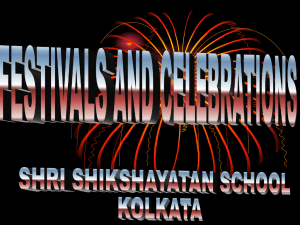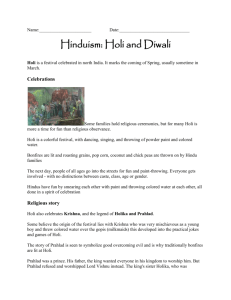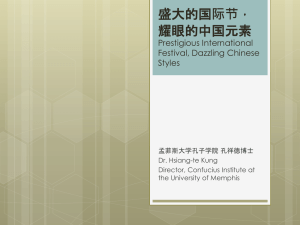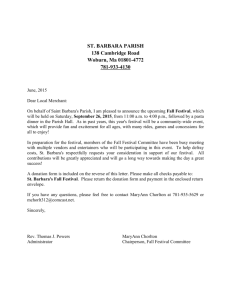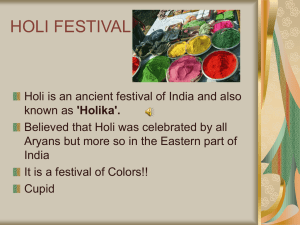Indian Holidays - Feric
advertisement
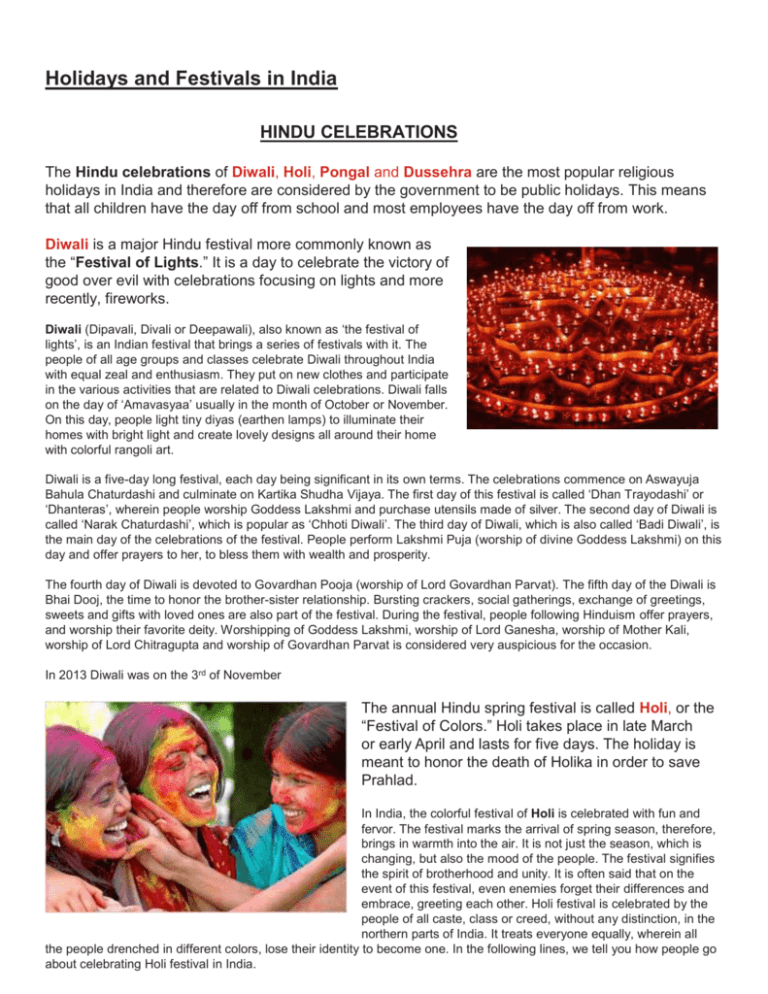
Holidays and Festivals in India HINDU CELEBRATIONS The Hindu celebrations of Diwali, Holi, Pongal and Dussehra are the most popular religious holidays in India and therefore are considered by the government to be public holidays. This means that all children have the day off from school and most employees have the day off from work. Diwali is a major Hindu festival more commonly known as the “Festival of Lights.” It is a day to celebrate the victory of good over evil with celebrations focusing on lights and more recently, fireworks. Diwali (Dipavali, Divali or Deepawali), also known as ‘the festival of lights’, is an Indian festival that brings a series of festivals with it. The people of all age groups and classes celebrate Diwali throughout India with equal zeal and enthusiasm. They put on new clothes and participate in the various activities that are related to Diwali celebrations. Diwali falls on the day of ‘Amavasyaa’ usually in the month of October or November. On this day, people light tiny diyas (earthen lamps) to illuminate their homes with bright light and create lovely designs all around their home with colorful rangoli art. Diwali is a five-day long festival, each day being significant in its own terms. The celebrations commence on Aswayuja Bahula Chaturdashi and culminate on Kartika Shudha Vijaya. The first day of this festival is called ‘Dhan Trayodashi’ or ‘Dhanteras’, wherein people worship Goddess Lakshmi and purchase utensils made of silver. The second day of Diwali is called ‘Narak Chaturdashi’, which is popular as ‘Chhoti Diwali’. The third day of Diwali, which is also called ‘Badi Diwali’, is the main day of the celebrations of the festival. People perform Lakshmi Puja (worship of divine Goddess Lakshmi) on this day and offer prayers to her, to bless them with wealth and prosperity. The fourth day of Diwali is devoted to Govardhan Pooja (worship of Lord Govardhan Parvat). The fifth day of the Diwali is Bhai Dooj, the time to honor the brother-sister relationship. Bursting crackers, social gatherings, exchange of greetings, sweets and gifts with loved ones are also part of the festival. During the festival, people following Hinduism offer prayers, and worship their favorite deity. Worshipping of Goddess Lakshmi, worship of Lord Ganesha, worship of Mother Kali, worship of Lord Chitragupta and worship of Govardhan Parvat is considered very auspicious for the occasion. In 2013 Diwali was on the 3rd of November The annual Hindu spring festival is called Holi, or the “Festival of Colors.” Holi takes place in late March or early April and lasts for five days. The holiday is meant to honor the death of Holika in order to save Prahlad. In India, the colorful festival of Holi is celebrated with fun and fervor. The festival marks the arrival of spring season, therefore, brings in warmth into the air. It is not just the season, which is changing, but also the mood of the people. The festival signifies the spirit of brotherhood and unity. It is often said that on the event of this festival, even enemies forget their differences and embrace, greeting each other. Holi festival is celebrated by the people of all caste, class or creed, without any distinction, in the northern parts of India. It treats everyone equally, wherein all the people drenched in different colors, lose their identity to become one. In the following lines, we tell you how people go about celebrating Holi festival in India. Celebrating Holi Festival In India Holi Milan Within Family The vibrant colors of Holi bring people closer to even their foes and make them forget all the anguish of the past. After applying colors, people hug and greet each other. This tradition is called as ‘Holi Milan’. Usually after a fun filled and action packed day, people dressed in new white colored clothes pay visit to their friends and relatives with sweets, typically Gujia. This helps in renewing and strengthening their social bonds. As per the custom, a plate decorated with tilak (vermillion) and sweets is kept ready for the guests. People apply tilak, exchange sweets and hug each, while exchanging Holi wishes. They are reenergized by being in the company of near and dear ones. Those staying away from their families opt for greeting cards and telephone to greet each other. Special invitations are extended to new bride, which helps her to feel comfortable and mingle with the members of her new family. Special meal is prepared on the occasion to treat her well and to bless the newly wed couple. Social Holi Milan ‘Holi Milan Samaroh’ or ‘Holi Greeting Meets’ are a special feature of the festival and are organized by various clubs and social organizations. This helps in strengthening the social fabric of the society, as people sit together and enjoy cultural programs like songs, dance, competitions and feasts. Hasya Kavi Sammelan (Comic Poetic gatherings) is also organized on Holi. Poets recite comic prose and poetry for the entertainment of the audience, which adds up to the fervor of the festival. Mouth watering sweets like gujiya, malpuas, mathri, puran poli and dahi badas are savored with full glasses of special thandai (cold drink made of almonds, spices, chilled milk and sugar) is served, in which bhang is mixed to create an alcoholic effect. It is a custom to serve bhang in many parts of the country. Apart from thandai, pakoras and vada made of bhang are also served. Pongal is an Indian festival celebrated in order to give thanks for the harvest. It is traditionally celebrated at the time of harvesting of the crops, and as a result is a celebration of the success related to the event. The word Pongal, in both Telugu and Tamil, signifies the boiling over of the rice in the cooking pot. Though little is known about the origin of Pongal, it is known to a Dravidian harvest festival that has survived for ages. Pongal also marks the beginning of a New Year and is the day to praise and thank God with full devotion, faith and sincerity. The festival covers all living beings, including humans, cattle and birds and crops. Falling just after the winter solstice and a bountiful harvest, Pongal marks the season of celebration and joyous activities and is celebrated continuously for four days. Dussehra is among the most important festivals celebrated in Southern India. As a 10-day celebration, there are activities ranging from worshipping goddesses to exhibiting colorful toys. It is also known as the day of worshipping weapons; more recently, “weapons” have been replaced with “tools of the trade,” therefore people worship items such as computers, cars, machines, and cooking utensils. Dussehra is the culmination of Navaratis in India. Popularly known as Vijayadashmi, Dussehra is celebrated with great enthusiasm, all over India. It is observed differently in different parts of the country, depending upon the legend that is followed in each region. In North India, Ramlila forms the highlight of Dusshera, while in south India, it is the triumph of Goddess Durga over Mahishasura that is celebrated. Eastern state of West Bengal has its own story connected to the festival, while in Mysore the concept of Shami tree is centered. Learn about the celebrations of Dussehra in different parts of India, by going through the following lines. Dusshera Celebrations In India In North India Ramlila is the backbone of the celebration of Dusshera in northern India, where the scenes from Rama’s life are depicted, especially Bharat Milap, the reunion of Rama with his brother Bharat, the destruction of Ravana (the highlight of Dussehra) and the return of Rama, Lakshmana and Sita to Ayodhya, their kingdom after fourteen years of exile. In Himachal Pradesh’s Kulu valley, the very ceremonial festivities and grand processions of the village deities of the hill people marks Dussehra. In Delhi and nearby states, oversized effigies of Ravana, Meghnath and Kumbhkaran are burnt in Ramlila, a mela that is organized by different committees, at huge grounds. It is a week long affair in the hill town of Kullu, in Himachal Pradesh. Deities are brought in process to ‘maidan’ in Kullu, to pay respect to the reigning deity of the place - Raghunathji. The huge procession consists of more than hundred deities that are mounted on the colorful palanquins. Ramlila is the next major attraction of Kullu Dusshera. In South India In Tamil Nadu, the nine days preceding Dussehra have been equally divided for worshipping the three Goddesses namely Lakshmi (the first three days are dedicated to the Goddess of wealth and prosperity), Saraswati (the next three days are dedicated to the Goddess of learning and arts) and Durga (the last three days are dedicated to Mother Goddess, Shakti). The women and children of Tamil Nadu, Andhra Pradesh and Karnataka arrange small statues and dolls, known as ‘Bommai Kolu’, on artificial steps and decorate the steps and the nearby place with beautiful lamps and flowers. From the very first day of the festival, songs and stories form a part of the celebration and a dish made out of chickpeas known as ‘choondal’ is made for the dolls as prasad to relish on. Vijayadashmi is the day when the Bommai Kolu is taken down ceremoniously. On the day of Vijayadashami, vidya aarambh (vidyaarambam) is observed. The day is considered very auspicious, especially for the children to begin their education in academics as well as art. Saraswati puja is done on Vijayadashami. A similar tradition can be seen in Kerala as well. Mysore is famous for a gala procession of richly bedecked elephants on the brightly lit streets of the city on Dussehra. In Mysore, effigies of Ravana, Meghnath and Kumbhkaran are burnt. The Mysore palace is illuminated for a whole month during the festive season of Dussehra. Caparisoned elephants lead a colorful procession through the vibrantly decorated streets of the princely city. In Andhra Pradesh, Dussehra is popularly referred to as Dasara. In East India In the eastern state of West Bengal, Vijayadashmi is celebrated as the victory of Goddess Durga over Mahishasura, the demon who ruled the swarglok and the earth with his invincible power. It is the last day of the ten-day festival - Durga Puja. On Vijayadashmi, the idol of Ma Durga is immersed in the nearby river or lake ceremoniously, by the devotees. This is called visarjan (submersion of deity). The idol is preceded by a huge procession of devotees. In Orissa, the festival is called Vijoya Dashami. The day is considered the last day of the Sharodiya Durga Puja. After offering the last ritual (Aparajita Puja) to the Goddess, a tearful farewell is bid to her. The immersion of deity is known as ‘Bisarjan Jatra’. After immersing the idol, people in Orissa celebrate ‘Ravan Podi’, wherein the effigies of demon Ravana are burnt. In West India In Maharashtra, Dussehra is celebrated on the tenth day of the Ashwin month, as per the Shaka Hindu Calendar. On the last day of Navratri, that is Dussehra, the idols installed on the first day of Navratri are immersed in water. Dussehra marks the victory of Lord Rama over Ravana. People celebrate the occasion with fun and fervor. They visit their friends and relatives and exchange sweets. Aapta tree is worshipped on this day. Exchange of leaves of aapta tree is considered auspicious. The legend of Shami tree, under which the Pandavas of Mahabharata stored their weapons during their 12 years of exile, is associated with the celebrations. As per the legend, the weapons were retrieved by them on this day. Dussehra is considered auspicious to start any new venture, according to the Maharashtrians.


